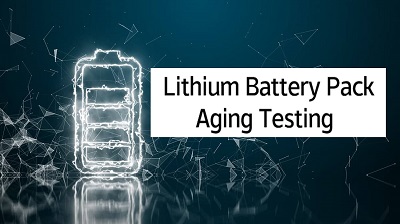Aging Test About Lithium Battery Pack
The activation stage of lithium battery pack includes precharge, formation, aging, constant capacity and so on. There are two main factors influencing the performance of lithium battery pack, namely aging temperature and aging time. What’s more, it is important that the battery tested in the aging test chamber is in a sealed state. If it is a battery on, the data for the test will be very different, which needs to be paid attention to.
Aging generally refers to the placement of the battery after the first charging after the completion of liquid injection. It can be aging at room temperature or at high temperature. Its function is to stabilize the properties and composition of the SEI film formed after the first charging. The aging temperature is 25℃. High temperature aging varies from factory to factory, some of which are 38℃ or 45℃. Most of the time is controlled between 48-72 hours.
Effect of aging test on lithium battery pack
First effect is to make the electrolyte soakage better, which is conducive to the stability of lithium battery pack performance;
Second, after aging, the active substances in the anode and cathode materials can accelerate some side effects, such as gas production, electrolyte decomposition, etc., which can quickly stabilize the electrochemical performance of lithium battery pack;
The third is to select the consistency of lithium battery pack after aging for a period of time. The measured value will deviate from the actual value due to the unstable voltage of the cell after formation, and the voltage and internal resistance of the cell after aging are more stable, which is convenient to select the battery with high consistency.
The battery performance is more stable after high-temperature aging. Most lithium battery manufacturers adopt high-temperature aging operation mode in the production process, and the temperature is 45℃-50℃ aging for 1-3 days, then set aside at room temperature. After high temperature aging, potential adverse phenomena of batteries will be exposed, such as voltage change, thickness change and internal resistance change, which directly test the safety and electrochemical performance of these batteries.
Temperature has a great influence on the cycle aging rate of lithium batteries. At lower temperature, the cycle life is reduced due to the enhanced lithium plating; High temperature can shorten the battery life due to the aging reaction driven by Arrhenius; Therefore, the best cycle life of lithium battery pack can be obtained only at appropriate temperature.
In fact, the real acceleration of lithium battery pack aging is not fast charging, but your charging habits! Fast charging will accelerate the aging of batteries. With the increase of usage times and time, aging of lithium batteries is inevitable, but good maintenance methods can prolong the service life of batteries.
How to select high temperature aging room equipment for lithium battery aging?
Lithium batteries need high temperature aging room for high temperature aging, low temperature and temperature cycling. Under various temperature conditions and changes, they are integrated with the charging and discharging system to carry out overcharge, discharge and short circuit tests at various temperatures. It is evaluated that joule heat accumulation will occur during the test process of lithium batteries, resulting in the temperature rise of batteries, and the risk of thermal runaway of internal materials of batteries, Once the battery thermal runaway and combustion.
In order to ensure the safety of lithium battery pack during various temperature changes and charge discharge related tests, a remote camera can be set up through the window to monitor the test and detect the surface temperature of each battery. If there is abnormal temperature rise on the surface of the battery, it is very likely to be dangerous. The system immediately starts the safety protection mechanism, assuming that when the battery explodes instantaneously, The high-strength inner furnace can withstand the explosion power, and the standard explosion-proof hole can also vent the explosion pressure. The special testing machine for lithium battery will detect its fire state, and immediately put out the fire and cool it down. After the fire is put out, the organic volatile gas and odor gas in the box will be discharged through the exhaust mechanism, so as to ensure the cleanliness of the laboratory, Through a number of international standards required by the lithium battery safety test, in order to avoid lithium battery explosion, combustion, and other concerns.
To sum up, the high temperature aging test chamber should not only have very powerful hardware facilities, but also meet the international test standards. In addition, the quality of high temperature aging test chamber in the market is uneven, so it is very difficult to choose the high quality and suitable high temperature aging test chamber. If you don’t want to waste too much time and energy, it is recommended to choose DGBELL’s high temperature aging test chamber directly.
DGBELL’s Temperature Aging Test Chamber is widely used for the aging test for electronic products, solar panel, plastic products, especially for battery temperature aging test.
Characteristics
- Outside SECC steel, fine powder coating treatment. Inner SUS#304 stainless steel.
- Use new heat resistant long shaft motor.
- Turbine fan.
- Silicone forced tight.
- Over-temperature protection, super load automatic power system.
- Circulation system: air force level cycle.
- Heating system: PID + S.S.R.
- Safety timer: when the temperature reaches a certain height and exceeds the set time, the alarm indicator of the device will be on quickly to warn the tester.
- For the glass window that can observe the interior of the test chamber, we can customize the design on the original conventional products according to the special needs of customers. It can well reflect our strength of product customization in many aspects.
The above is only the main features of the product, for the hardware of the equipment has been more complete description, can carry out a complete process of lithium battery aging test. Believe that this is enough to remove most of your doubts. More specific equipment parameters can be accessed on the official website of DGBELL. If necessary, please let us know about your needs by email, telephone, etc. We will give product suggestions according to your needs as soon as possible, or provide customized solutions. DGBELL is one of the world’s top manufacturers and suppliers of battery safety and stability test chamber. All products are sold at factory price. Please feel free to purchase. Welcome to your inquiry.











